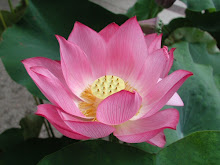* Dana has left the animal behavior lab course and I'm therefore alone on the job. Not that I mind; I much prefer working alone rather than having to synchronize everything with other people. Also news on the course is that the martes are making a full use of their enclosure's branches, shelves and various entertainment facilities and despite the fact that they do show some repeatative behavior, they're also doing a whole lot more (only about 10% of what they've been doing was repeatative behavior) while the hyena's spening half an hour pacing without noticing what's going on around him...so the martes are off the topic, but I'll make 'em toys anyways <3
* The new Legend chapter is out in my original fiction LJ and FictionPress, go read it.
Over and out.
Wednesday, May 28, 2008
Wednesday, May 21, 2008
A bit of history
Theres an employment fair in the university today, where various companies spread out their nets for enhgeneers and computer people (believe me, I looked, there's nothing for anyone else in there). Amungst the booths was a booth by Siemens, with the usual bumbling recruitment people and free candy to lure hungry peniless students into the flytrap. I approached one of the salesmen recruitment guys and asked him if he knew Siemens had factories in Auschwitz, Ravensbruck and was a general employer of forced labor and nazification during the second world war, that they actually produced crematoriums for Buchenwald. His answer was, after a small awkward silence, "uh....they don't do that anymore".
Yeah, Allies troops can do that to you sometimes...shame, isn't it?
Just for further reading, here's Siemens' official declaration of the subject in their website:
From 1933, National Socialist economic policy pursued two primary goals: combating unemployment and “militarization of the German economy.” 'combating unemployment is a funny way of saying 'firing jews and hiring gentiles A four-year plan was instituted in 1936 to ready the economy and the armed forces for war within the space of a few years. Like other sectors, the electrical industry received an increasing number of orders from public offices and was drawn into the program of war preparations. This development marked the onset of a phase of rapid growth that continued through to the end of World War II So, nazis are good for business, eh?.
Following its invasion of Poland in 1939, Germany embarked on a gradual transition to a war economy. The state restricted and even prohibited the production of certain civilian goods and requisites, and military conscription led to a widening shortage of labor. gee, you could have solved that by putting women into factories like the US, UK and Soviets did...or you can just put the women in the army, like the soviets, but women in the nazi idea was a baby factory (and the occasional guard dog when needed in camps) but never anything more useful than that... As a result, an increasing number of foreign civilians – men and women – were employed in manufacturing. Initially, they chose to work of their own free will re-writing history, ladies and gentlemen, is not just a Soviet feature; capitalists do it too ^_^. Later, though, many were forced into labor. They worked throughout German industry – in the manufacturing sector, in public services, and in agriculture. By the winter of 1941-42, the German economy had become entirely dependent on forced labor.
In late 1944, at the height of World War II, Siemens’ total workforce of 244,000 included some 50,000 people who had been put to work against their will. The overall number of men and women who served as forced labor at Siemens during the war years was, however, higher. No actual numbers and the number which do exist, I don't know of a source that can approve them, but that's something that can be checked
During the final years of the war, numerous plants and factories in Berlin and other major cities were destroyed by Allied air raids. To prevent further losses, manufacturing was therefore moved to alternative places and regions not affected by the air war. Like Poland? that was before 1944-1945... The goal was to secure continued production of important war-related and everyday goods. According to records, Siemens was operating almost 400 alternative or relocated manufacturing plants at the end of 1944 and in early 1945.
Germany’s political, military and economic collapse led to the closure of Siemens’ plants in Berlin on April 20, 1945. By the time the war came to an end, the greater part of Siemens’ buildings and industrial installations had been completely destroyed. The company’s overall losses resulting from World War II amounted to 2.58 billion reichsmarks – four-fifths of its total assets. Makes you cry, doesn't it? I mean, they were at a horrible loss, horrible, you see; they're the victims here, the army used them, the poor things.
Ugh.
Yeah, Allies troops can do that to you sometimes...shame, isn't it?
Just for further reading, here's Siemens' official declaration of the subject in their website:
From 1933, National Socialist economic policy pursued two primary goals: combating unemployment and “militarization of the German economy.” 'combating unemployment is a funny way of saying 'firing jews and hiring gentiles A four-year plan was instituted in 1936 to ready the economy and the armed forces for war within the space of a few years. Like other sectors, the electrical industry received an increasing number of orders from public offices and was drawn into the program of war preparations. This development marked the onset of a phase of rapid growth that continued through to the end of World War II So, nazis are good for business, eh?.
Following its invasion of Poland in 1939, Germany embarked on a gradual transition to a war economy. The state restricted and even prohibited the production of certain civilian goods and requisites, and military conscription led to a widening shortage of labor. gee, you could have solved that by putting women into factories like the US, UK and Soviets did...or you can just put the women in the army, like the soviets, but women in the nazi idea was a baby factory (and the occasional guard dog when needed in camps) but never anything more useful than that... As a result, an increasing number of foreign civilians – men and women – were employed in manufacturing. Initially, they chose to work of their own free will re-writing history, ladies and gentlemen, is not just a Soviet feature; capitalists do it too ^_^. Later, though, many were forced into labor. They worked throughout German industry – in the manufacturing sector, in public services, and in agriculture. By the winter of 1941-42, the German economy had become entirely dependent on forced labor.
In late 1944, at the height of World War II, Siemens’ total workforce of 244,000 included some 50,000 people who had been put to work against their will. The overall number of men and women who served as forced labor at Siemens during the war years was, however, higher. No actual numbers and the number which do exist, I don't know of a source that can approve them, but that's something that can be checked
During the final years of the war, numerous plants and factories in Berlin and other major cities were destroyed by Allied air raids. To prevent further losses, manufacturing was therefore moved to alternative places and regions not affected by the air war. Like Poland? that was before 1944-1945... The goal was to secure continued production of important war-related and everyday goods. According to records, Siemens was operating almost 400 alternative or relocated manufacturing plants at the end of 1944 and in early 1945.
Germany’s political, military and economic collapse led to the closure of Siemens’ plants in Berlin on April 20, 1945. By the time the war came to an end, the greater part of Siemens’ buildings and industrial installations had been completely destroyed. The company’s overall losses resulting from World War II amounted to 2.58 billion reichsmarks – four-fifths of its total assets. Makes you cry, doesn't it? I mean, they were at a horrible loss, horrible, you see; they're the victims here, the army used them, the poor things.
Ugh.
Saturday, May 17, 2008
LOL
* Tomorrow's invert lab is about flat worms, hooraah!
* I gave the nuts at cat_macros a gathering of the best Sam and Scarlett pics and this is what they came up with:
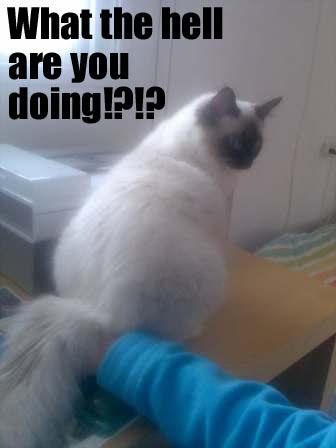
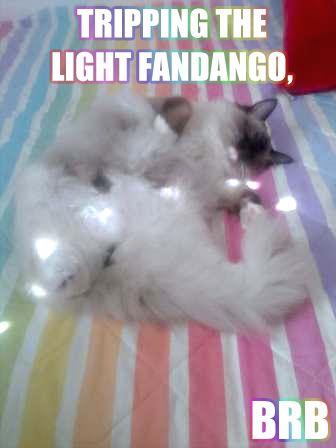


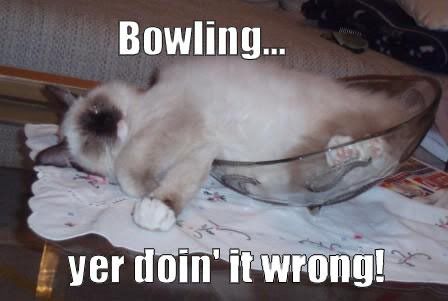

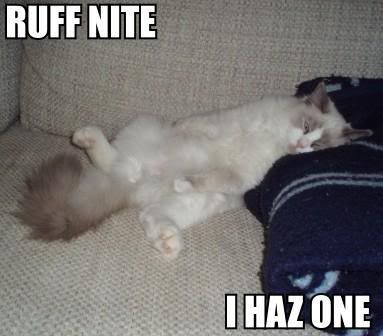
* Finished reading Salmon of Doubt and here's the Goodreads review:
It's a great shame that not only did we lose Douglas Adams as a writer, lecturer, protector of endangered species and funny man in general, but also that The Salmon of Doubt was never completed.
This book is a gathering of Adams' interviews, half-made ideas, small stories, lectures, articles and three chapters from his to-be new Drik Gently book. His writing is, as usual, timeless and wonderful, a treasurechest of wit and enlightening little remarks about the world humans in it and the techn...more It's a great shame that not only did we lose Douglas Adams as a writer, lecturer, protector of endangered species and funny man in general, but also that The Salmon of Doubt was never completed.
This book is a gathering of Adams' interviews, half-made ideas, small stories, lectures, articles and three chapters from his to-be new Drik Gently book. His writing is, as usual, timeless and wonderful, a treasurechest of wit and enlightening little remarks about the world humans in it and the technology we create.
It's a wonderful book and I highly recommend it.
Next up: A Historical Achievement and its Evolution by the Ben Guriun institution of Israeli studies. The name alone is a mis-use of the term 'evolution' but I'm being a petty nerd saying that.
* And speaking of Goodreads, I've just discovered I can manually type in all the too-local-to-be-on-Amazon books!! That's great, now I can type in all the holocaustic stuff.
* I gave the nuts at cat_macros a gathering of the best Sam and Scarlett pics and this is what they came up with:







* Finished reading Salmon of Doubt and here's the Goodreads review:
It's a great shame that not only did we lose Douglas Adams as a writer, lecturer, protector of endangered species and funny man in general, but also that The Salmon of Doubt was never completed.
This book is a gathering of Adams' interviews, half-made ideas, small stories, lectures, articles and three chapters from his to-be new Drik Gently book. His writing is, as usual, timeless and wonderful, a treasurechest of wit and enlightening little remarks about the world humans in it and the techn...more It's a great shame that not only did we lose Douglas Adams as a writer, lecturer, protector of endangered species and funny man in general, but also that The Salmon of Doubt was never completed.
This book is a gathering of Adams' interviews, half-made ideas, small stories, lectures, articles and three chapters from his to-be new Drik Gently book. His writing is, as usual, timeless and wonderful, a treasurechest of wit and enlightening little remarks about the world humans in it and the technology we create.
It's a wonderful book and I highly recommend it.
Next up: A Historical Achievement and its Evolution by the Ben Guriun institution of Israeli studies. The name alone is a mis-use of the term 'evolution' but I'm being a petty nerd saying that.
* And speaking of Goodreads, I've just discovered I can manually type in all the too-local-to-be-on-Amazon books!! That's great, now I can type in all the holocaustic stuff.
Monday, May 12, 2008
Cat crib - UR DOING IT WRONG

Sam loves getting under mobile objects and slither around on his belly, at top speed, towards things (mostly people, Scarlett and table legs). This saturday he did it with their new cat tent, usually he does it with his beloved paper bag.
Scarlett and the tend. Whenever Sam's having a good time in the tent, she'l get in it and kick him out. She does that with his bowl, too, and with any toy he's playing with. His revenge - come gushi-food time he'll nudge her away from her plate to pig it out (often before he finished his share!)
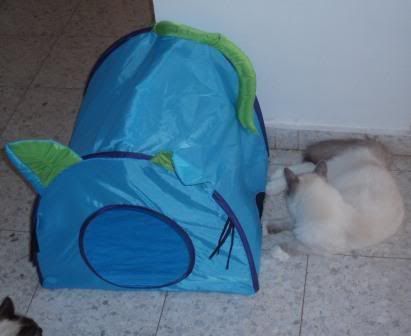
The lovely fluffers
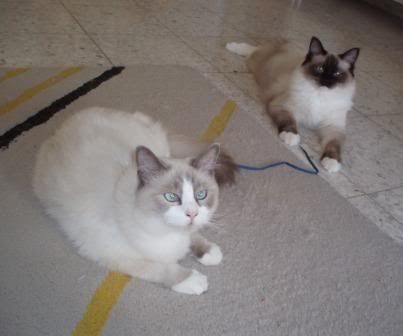
Sam and his bowl. As you can see, he grew into it a little, the little fluff and blubber lump that he is >.<
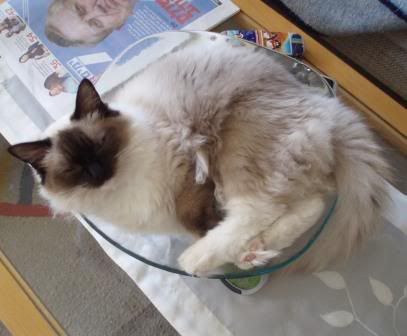
The glass gives a good view to smeared-curled paws!
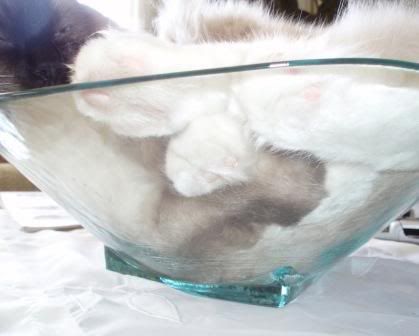

Do any of you long-haired cat owners see these on your cats; curly areas in the middle of the smooth fur? Sam's got these in the fur on the sides of his belly and on the rear of his thighs and they reappear again after we comb him (we do this every day)
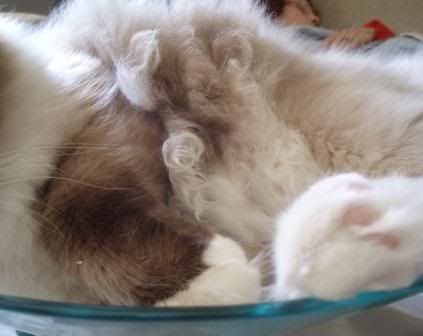
Snuggled up
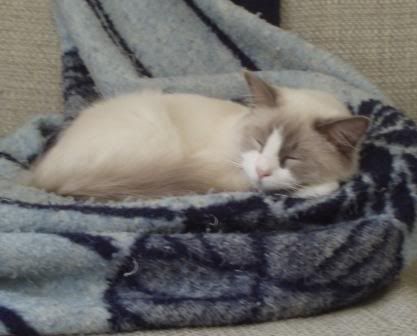
Very pleased with his bowl and with existance in general
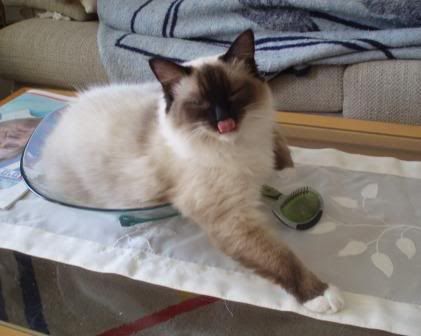
Finished reading Darwin's The Expression of the Emotion in Humans and Animals, here's the Goodreads review:
This book is more a historical document than a scientific paper, by today's requirements for scientific documents.
Darwing collects here his notes on the expressions of humans with a single chapter about animals and some referrences to monkeys, so the title is highly misleading (it annoyed me, anyways).
Despite that, this work is at the root of understanding both human and animal behavior and the three principles of expression are now evidently the base of every modern theory on animal and h...more This book is more a historical document than a scientific paper, by today's requirements for scientific documents.
Darwing collects here his notes on the expressions of humans with a single chapter about animals and some referrences to monkeys, so the title is highly misleading (it annoyed me, anyways).
Despite that, this work is at the root of understanding both human and animal behavior and the three principles of expression are now evidently the base of every modern theory on animal and human behavior and that, in itself, gives this book a historical value.
Darwing depicts his notes on his own children, on various and un-measured sightings of human and animal beahvior (like "I once saw a girl doing ___ " or "my neighbour's dog once ___ ") which nower days would be completely unfit for scientific research. Those were the days, though, and for anyone interested or amused by the development of scientific thinking and research this book is an enjoyable gem.
Another historical value this book has is in the fact that, in order to investigate human expression in human societies relatively unexposed and influenced by Eurpoean man, Darwin had a small army of informants at remote Biritsh colonies investigating and reporting of their experiences with the local natives. These informants were judges, policemen, missionaries and wives of various officials. With these times long gone (thankfully), it's a reminder and a documentation of the spirits of the time and the way these far-away cultures, still unchanged at the time, behaved.
This book is not an easy read as the english is that of Victorian times and often words that mean one thing to us mean another, when he author is concerned, and the unabridged version hold a lot of repeating and coarse writing that's not for readers who just want an easy book to stare at.
Still, it's a good book, and for historians with a love for human studies, it's a good book
Am now reading: Douglas Adams' The Salmon of Doubt
Thursday, May 8, 2008
Happy birthday, Israel
* The second semester started and though the fallen soldiers memorial day and independence day cut two days off the week I managed to experience most of the classes (save for Evolution). So far so good, and here's what we have this time:
Microbiology - the prof. of which is a chubby and huggable little Sweedish Chef lookalike who's prone to smiles and staying off boring subjects.
Mulecular Biology - lead by a prof who sort of looks like Christopher Ryan with a little more hair. So far, boring as hell, actually, but tolerable.
Invertebrates Lab - only had classes so far but it's fun fun fun; lots of cool facts about inverts!
Evolution - which I have yet to have a class in but it should be interesting, lead by the last prof who taught us Animal Behavior.
Animal Behavior lab - AWESOM!! Hooked up with uni-gang-member Dana to work on steriotypical beharion (a.k.a pacing in our case) in the striped hyena and stone martens of the zoology garden.
* We're so kicking ass with that animal behavior lab project; we already have the experiment procedures figured out and a plan all ready and that SO impressed the guides and prof, way cool. We're going to make toys so the little beasts won't be bored and neurotic which also contributes to their quality of life ^_^
* Today is independence day for Israel and we celebrated by going to Jerusalem's Israel museum and science museum. The first was very nice, had a lovely mini model of Second Temple Jerusalem and the Kumeran scrolls along with some modern art I wasn't bothered with and a show of liberated art stolen from jews by the nazis.
The science museum was fun and cool and the exhibition about medicins and drugs had a bit where you can build molecules from beads and bonds and such and I made Alanine in a peptide bond with Cistein. Yes. Nerdy. I know.
The first museum also had a fantastic book about crusaders in Israel, their beginning, their various waves of conquest and their way of life and I got it for almost 200 shekels less its original price because the cover was mis-glued to the paper. Luckily, my grandfather worked at a printing house and dad knows a thing or two on fixing these things. Basically, I got an extremely cool book for dirt cheap ^_^
Ta ta!
Microbiology - the prof. of which is a chubby and huggable little Sweedish Chef lookalike who's prone to smiles and staying off boring subjects.
Mulecular Biology - lead by a prof who sort of looks like Christopher Ryan with a little more hair. So far, boring as hell, actually, but tolerable.
Invertebrates Lab - only had classes so far but it's fun fun fun; lots of cool facts about inverts!
Evolution - which I have yet to have a class in but it should be interesting, lead by the last prof who taught us Animal Behavior.
Animal Behavior lab - AWESOM!! Hooked up with uni-gang-member Dana to work on steriotypical beharion (a.k.a pacing in our case) in the striped hyena and stone martens of the zoology garden.
* We're so kicking ass with that animal behavior lab project; we already have the experiment procedures figured out and a plan all ready and that SO impressed the guides and prof, way cool. We're going to make toys so the little beasts won't be bored and neurotic which also contributes to their quality of life ^_^
* Today is independence day for Israel and we celebrated by going to Jerusalem's Israel museum and science museum. The first was very nice, had a lovely mini model of Second Temple Jerusalem and the Kumeran scrolls along with some modern art I wasn't bothered with and a show of liberated art stolen from jews by the nazis.
The science museum was fun and cool and the exhibition about medicins and drugs had a bit where you can build molecules from beads and bonds and such and I made Alanine in a peptide bond with Cistein. Yes. Nerdy. I know.
The first museum also had a fantastic book about crusaders in Israel, their beginning, their various waves of conquest and their way of life and I got it for almost 200 shekels less its original price because the cover was mis-glued to the paper. Luckily, my grandfather worked at a printing house and dad knows a thing or two on fixing these things. Basically, I got an extremely cool book for dirt cheap ^_^
Ta ta!
Friday, May 2, 2008
It's been ages.....
And I have so much to tell...
* Test season's over! This tuesday was the last test - Biochemistry - and what a test it was, good lord. Anyone who was asked about it complained about how difficult it was, which is perfectly understandable since the questions were never on the processed and cycles we learned but on teeny, meaningless details and petty things half of which we either heard a tiny bit about in sidenotes or things we were told will not be included in the test....way to go, assholes.
So far I'm taking Genetics, Animal Behavior and Anymal Physiology re-takes to improve my score on them and get my average bounced a bit.
Microbiology Lab test turned up to be quite the sweetheard; 86%!! first calculative-science test I got such a high score in, and it's got a heavy influence on the average, too, so that's sweet as hon-ey.
The next semester starts this sunday, which means I had 4 days to rest, relax and get ready for the new semester....lovely, innit?
* A tiny kitten was brought to the public garden/yard/walkway under my building by the cat-feeding-friend in the neighborhood. A cute little energetic male white and ginger fluffball, he stayed around for about two weeks, getting fed and played with by me three times a day (the friend who brought him coming to visit him as well, as well as another cat feeding friend from my building) and three days ago he was seen playing with two young ladies and later appeared no more in the shrubbery where he lived so, though I wasn't around to confirm it, he was adopted. Hopefully the little bugger's found a tolerant home because, as rediculously cute as he was, he had a nasty habit of biting as hard as possible when in a playing fit.
* Top celebrate the end of the test season, I joined a two day hike with two faculty friends in the Golan Hights. Though I worked a year in escorting trips and hikes around the country, I never had any hike that was this difficult or with the whole two days' equipment on my back (and, believe me, it makes a difference!) but, my god was it fun!!
We took a bus up north to Kiryat Shmone and slept the night there, hitchhiked our way to the start of the trip on the next morning, Making our way down from the middle of the Hermon mountain and surrnounding mountains's ridges, walked about 10 hours from our start point to our nightly resting point. the next day we finished decending the Golan Hights and into the Hulla valley through streams and beautiful, lush green land. It's a good season to hike in the Golan; right after the winter's freezing cold and before the summer sets in and makes everything yellow and dry. I had a ball of a time and traveling with two other nature fans who fawn over insects and other animals and flowers like you's great, great fun.
Piccies!!
A lovely butterfly we found on the side of the road and chased around like idiots to get good shots of, while trying to keep it off the road.
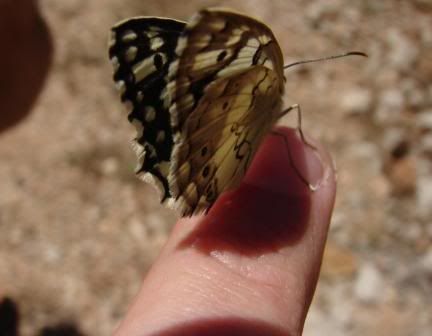


What a looker.
View of the road we decended. We hiked through the various fields and groves and made out way to the little brown buldge you see to the right of the picture which is Kalat Namrud.
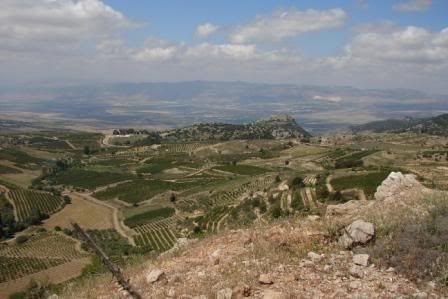
A tiny turtle we found on our way, chatting with some frogs in a small stream. He had an incredibly long tail!

If it's hard to spot the insect in the picture, imagine spotting it in life size (even tinier), which Zohar, one of the two guys I hiked with, managed it. The insect was perfectly camoflagued as a piece of drifting seeds the kind that flowers give way. Lovely thing.
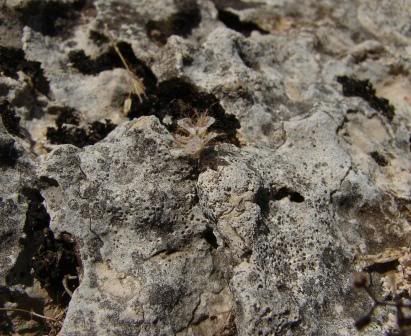
Some lovely blooming on a ground-splayed nettle.
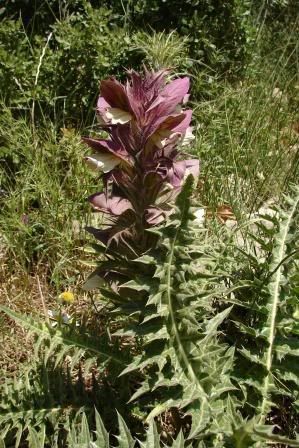
A slightly closer view of Kalat Namrud.
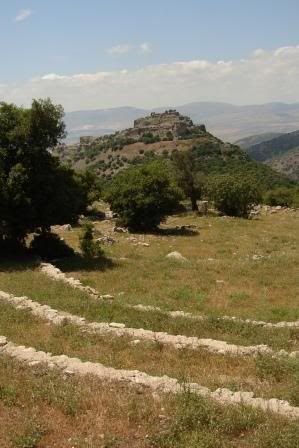
View up at one of Kalat Namrud fort's guard towers
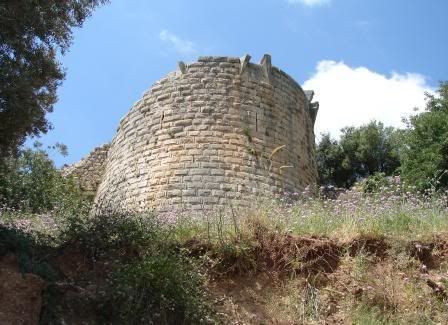
The company. To the left is Zohar; a zoology-bound student who works with fresh water insects and hopes to find his niche in nature conservation and find a cute to human over population. To the right is Nativ; a Geography-Biology student who's inclined more towards the biology and hopes to find his spot in ecology. Both guys are quite the expert hikers and came equiped with all the gear, maps ect.
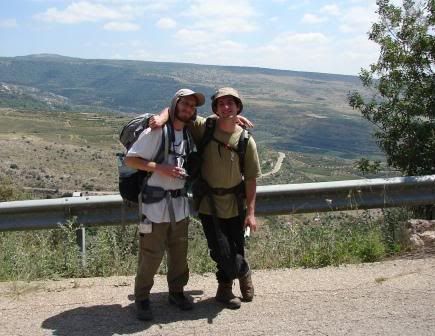
A part of the re-built fort at Kalat Namrud. The fort was originally built by the Mamluks a the beginning of the 13th century. After an attempted conquest by crusaders, it was regained by the muslims and renovated lavishly to its current and much larger shape with lots of halls, guard towers and particularly strategic gate (an 'L' shaped entry with a very narrow corridor so as to block any direct horde invasion with horses/spears/whathaveyou which can also be seen in the same-period main gate in the wall around the ancient city of Jerusalem)
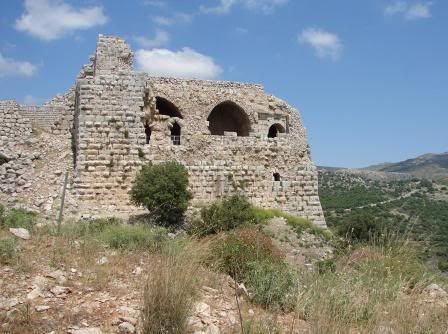
View at the Hulla valley and some leftovers of the Golan Hights from the fort.
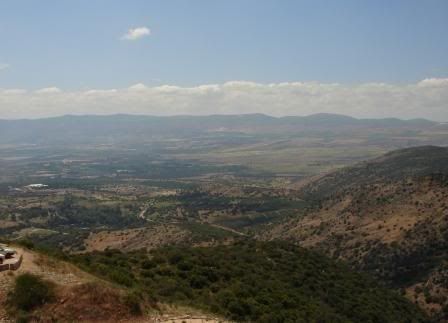
A carved declaration of glorification to the re-builders of the fort including details about when the fort was rennovated, who was its architect, the sponsor and the area's warlord who settled in the fort.
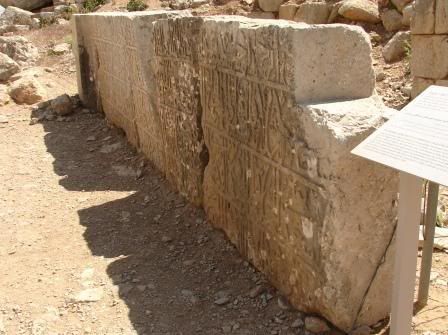
Yours truely on some scattered rocks in one of the fort's yards. Te climb on that rock cost my left shin some skin....
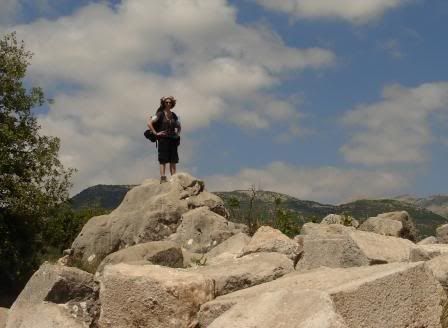
The guys on the top of the new castle's guard tower top. It was insanely windy up there as you can see by the wincing Nativ.
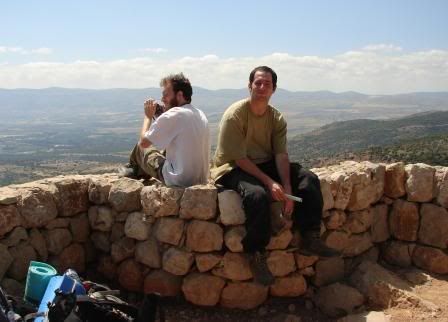
View to the old and original fort.
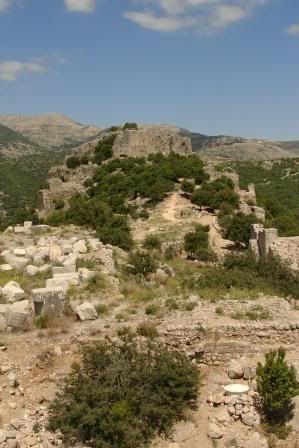
A lion carving found in one of the halls. It closely resembles the much earlier Assurian carving of lion hunts and other bragging depictions from the Persian area, IMO anyways.
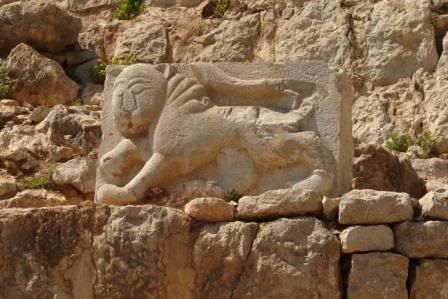
Over time, one of the lowest halls became filled with water and the cielling collapsed after various earthquakes and now the place's filled with pea soup (not really, but it looks like it, don't it? 8D)
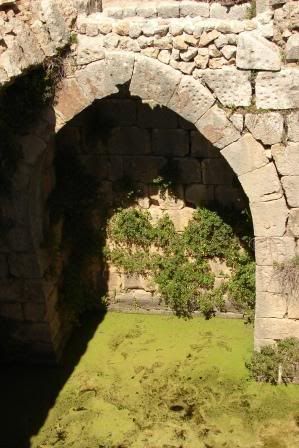
View at the western wall of the fort, along the line of the new fortification with its guard towers and the older part.
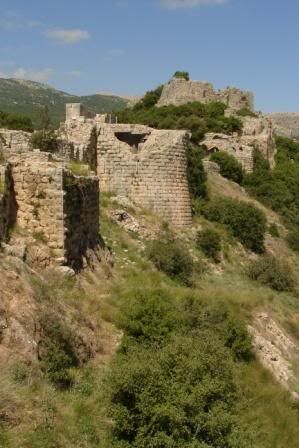
Inside the 'Beautiful Tower', a guard tower with seven arches and a seven-edged pillar in the center, each arch with its medivel firing slit.
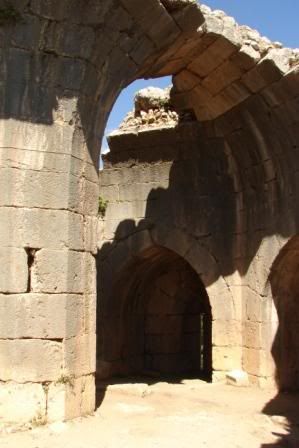
Such as this:
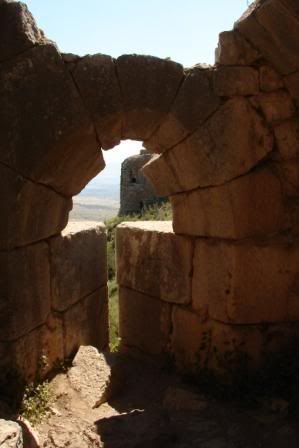
View at the new fort from the old fort tower.
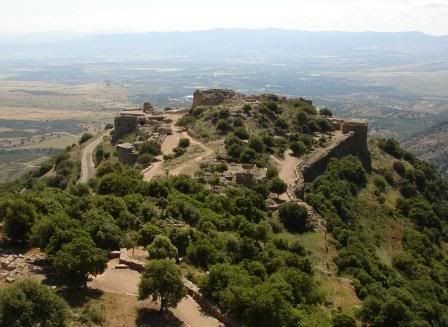
We almost finished decending from the mountain on which Kalat Namrud was perched and were about to decend more to the Banias river nature reserve on which we had a clear view of (and where I spotted a rather large hyrax, the only one of its kind which I saw in the whole trip) when a grasshopper nymph caught our eye.
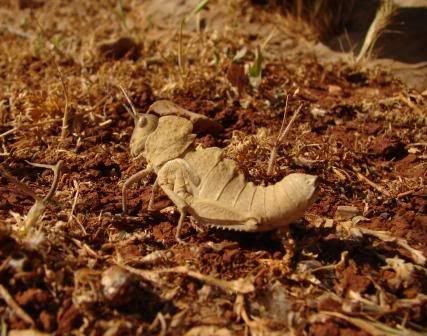
The Bainias fall. Down its stream we found a place to perch and spend the night in the reserve, near a bend in the river, under the tree's canopy. Before we entered the Banias resevre Zohar, who had a lot of work in his lab, left us and the next day was jus me and Native.
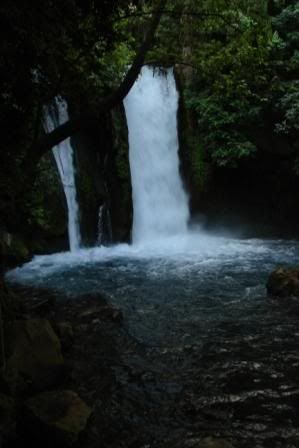
The Banias' trail through the thick bush and forest on the final trail from the Golan to the Hulla.
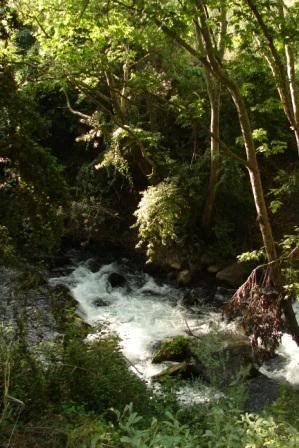
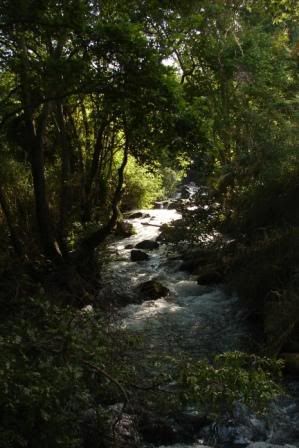
Dragonfly; not just a lovely Fleetwood Mac song.
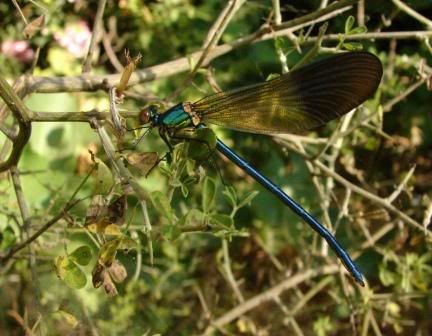
Some botany.

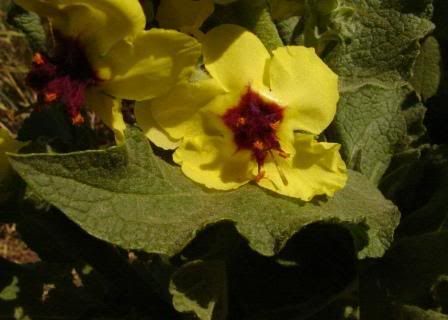
A trailer we found on a resting point in Shear Yeshuv village at the end of the Bainas resevre. The whole resting stop was full of these mosaic-works; the picnic tables, the various flower pots, some of the floor tiles, quite some work.
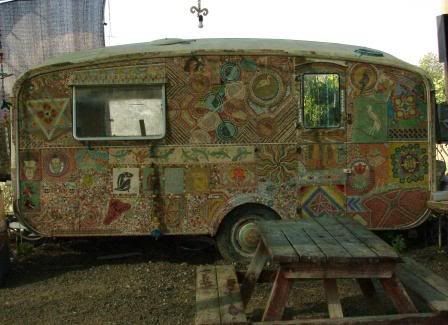
Turtles in a small stream by Dafna kibbutz.
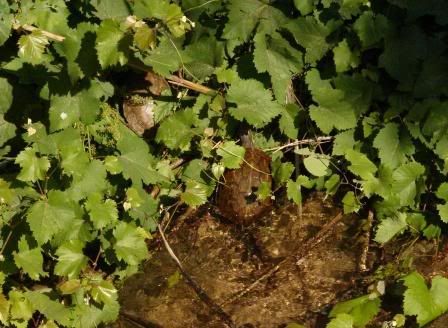
A crab at a smililar stream further down the road.
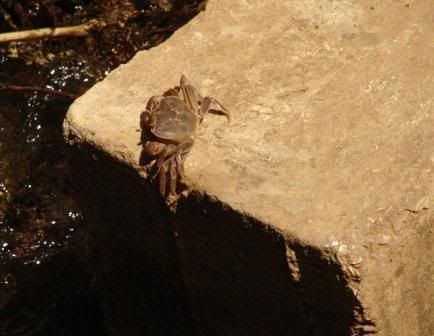
View from the edge of one of the kibbutz's fields at the area we hiked a day before. The kibbutz sealed off the thicket at the stream's edge (probably clearing the land to make for agricultural processing), leaving around the stream only a skeletal coverage of the actual stream of the natural wild greenery and broadered it all off with a lowe electric fence against wild boars....the field itself was fenced off so there's no free access for humans nor animals...aren't humans great -_-
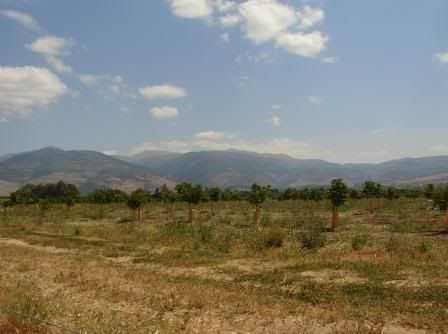
A cock up a tree in a by-the-stream fish restaurant on the Snir stream. We had a bathroom stop there, no dining.
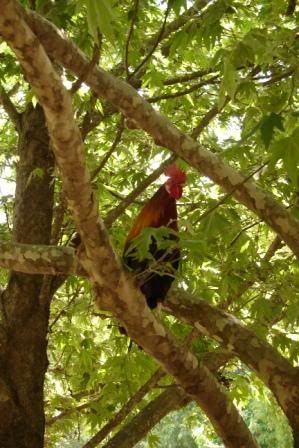
A small cascade on the Snir stream trail. We took a swim in the stream's freezing cold water (its a melting-snow water stream and the season was early enough for it to be still chilly) which was quite rediculously fun.
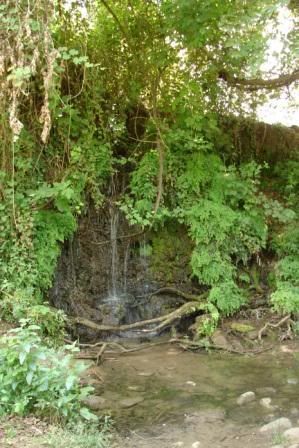
A huge tree on the Snir's stream. Much of the trail there was through the water.
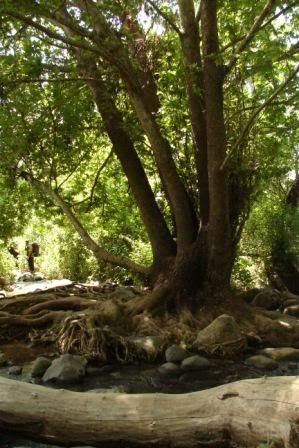
And that's that! See you in the next semester....
* Test season's over! This tuesday was the last test - Biochemistry - and what a test it was, good lord. Anyone who was asked about it complained about how difficult it was, which is perfectly understandable since the questions were never on the processed and cycles we learned but on teeny, meaningless details and petty things half of which we either heard a tiny bit about in sidenotes or things we were told will not be included in the test....way to go, assholes.
So far I'm taking Genetics, Animal Behavior and Anymal Physiology re-takes to improve my score on them and get my average bounced a bit.
Microbiology Lab test turned up to be quite the sweetheard; 86%!! first calculative-science test I got such a high score in, and it's got a heavy influence on the average, too, so that's sweet as hon-ey.
The next semester starts this sunday, which means I had 4 days to rest, relax and get ready for the new semester....lovely, innit?
* A tiny kitten was brought to the public garden/yard/walkway under my building by the cat-feeding-friend in the neighborhood. A cute little energetic male white and ginger fluffball, he stayed around for about two weeks, getting fed and played with by me three times a day (the friend who brought him coming to visit him as well, as well as another cat feeding friend from my building) and three days ago he was seen playing with two young ladies and later appeared no more in the shrubbery where he lived so, though I wasn't around to confirm it, he was adopted. Hopefully the little bugger's found a tolerant home because, as rediculously cute as he was, he had a nasty habit of biting as hard as possible when in a playing fit.
* Top celebrate the end of the test season, I joined a two day hike with two faculty friends in the Golan Hights. Though I worked a year in escorting trips and hikes around the country, I never had any hike that was this difficult or with the whole two days' equipment on my back (and, believe me, it makes a difference!) but, my god was it fun!!
We took a bus up north to Kiryat Shmone and slept the night there, hitchhiked our way to the start of the trip on the next morning, Making our way down from the middle of the Hermon mountain and surrnounding mountains's ridges, walked about 10 hours from our start point to our nightly resting point. the next day we finished decending the Golan Hights and into the Hulla valley through streams and beautiful, lush green land. It's a good season to hike in the Golan; right after the winter's freezing cold and before the summer sets in and makes everything yellow and dry. I had a ball of a time and traveling with two other nature fans who fawn over insects and other animals and flowers like you's great, great fun.
Piccies!!
A lovely butterfly we found on the side of the road and chased around like idiots to get good shots of, while trying to keep it off the road.



What a looker.
View of the road we decended. We hiked through the various fields and groves and made out way to the little brown buldge you see to the right of the picture which is Kalat Namrud.

A tiny turtle we found on our way, chatting with some frogs in a small stream. He had an incredibly long tail!

If it's hard to spot the insect in the picture, imagine spotting it in life size (even tinier), which Zohar, one of the two guys I hiked with, managed it. The insect was perfectly camoflagued as a piece of drifting seeds the kind that flowers give way. Lovely thing.

Some lovely blooming on a ground-splayed nettle.

A slightly closer view of Kalat Namrud.

View up at one of Kalat Namrud fort's guard towers

The company. To the left is Zohar; a zoology-bound student who works with fresh water insects and hopes to find his niche in nature conservation and find a cute to human over population. To the right is Nativ; a Geography-Biology student who's inclined more towards the biology and hopes to find his spot in ecology. Both guys are quite the expert hikers and came equiped with all the gear, maps ect.

A part of the re-built fort at Kalat Namrud. The fort was originally built by the Mamluks a the beginning of the 13th century. After an attempted conquest by crusaders, it was regained by the muslims and renovated lavishly to its current and much larger shape with lots of halls, guard towers and particularly strategic gate (an 'L' shaped entry with a very narrow corridor so as to block any direct horde invasion with horses/spears/whathaveyou which can also be seen in the same-period main gate in the wall around the ancient city of Jerusalem)

View at the Hulla valley and some leftovers of the Golan Hights from the fort.

A carved declaration of glorification to the re-builders of the fort including details about when the fort was rennovated, who was its architect, the sponsor and the area's warlord who settled in the fort.

Yours truely on some scattered rocks in one of the fort's yards. Te climb on that rock cost my left shin some skin....

The guys on the top of the new castle's guard tower top. It was insanely windy up there as you can see by the wincing Nativ.

View to the old and original fort.

A lion carving found in one of the halls. It closely resembles the much earlier Assurian carving of lion hunts and other bragging depictions from the Persian area, IMO anyways.

Over time, one of the lowest halls became filled with water and the cielling collapsed after various earthquakes and now the place's filled with pea soup (not really, but it looks like it, don't it? 8D)

View at the western wall of the fort, along the line of the new fortification with its guard towers and the older part.

Inside the 'Beautiful Tower', a guard tower with seven arches and a seven-edged pillar in the center, each arch with its medivel firing slit.

Such as this:

View at the new fort from the old fort tower.

We almost finished decending from the mountain on which Kalat Namrud was perched and were about to decend more to the Banias river nature reserve on which we had a clear view of (and where I spotted a rather large hyrax, the only one of its kind which I saw in the whole trip) when a grasshopper nymph caught our eye.

The Bainias fall. Down its stream we found a place to perch and spend the night in the reserve, near a bend in the river, under the tree's canopy. Before we entered the Banias resevre Zohar, who had a lot of work in his lab, left us and the next day was jus me and Native.

The Banias' trail through the thick bush and forest on the final trail from the Golan to the Hulla.


Dragonfly; not just a lovely Fleetwood Mac song.

Some botany.


A trailer we found on a resting point in Shear Yeshuv village at the end of the Bainas resevre. The whole resting stop was full of these mosaic-works; the picnic tables, the various flower pots, some of the floor tiles, quite some work.

Turtles in a small stream by Dafna kibbutz.

A crab at a smililar stream further down the road.

View from the edge of one of the kibbutz's fields at the area we hiked a day before. The kibbutz sealed off the thicket at the stream's edge (probably clearing the land to make for agricultural processing), leaving around the stream only a skeletal coverage of the actual stream of the natural wild greenery and broadered it all off with a lowe electric fence against wild boars....the field itself was fenced off so there's no free access for humans nor animals...aren't humans great -_-

A cock up a tree in a by-the-stream fish restaurant on the Snir stream. We had a bathroom stop there, no dining.

A small cascade on the Snir stream trail. We took a swim in the stream's freezing cold water (its a melting-snow water stream and the season was early enough for it to be still chilly) which was quite rediculously fun.

A huge tree on the Snir's stream. Much of the trail there was through the water.

And that's that! See you in the next semester....
Labels:
Cats,
hiking,
picture post,
tests,
traveling the country
Subscribe to:
Posts (Atom)
